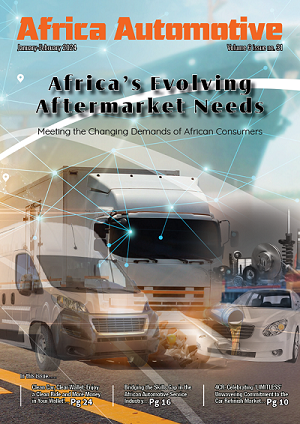By the end of this year, a pioneering three-way Industrial Partnership Agreement between South Africa, Ghana and Egypt could be a reality and the ignition to the rapid industrialisation and growth of the automotive industry in Africa – a lighthouse to the opportunity that exists within the world’s largest single market, the African Continental Free Trade Area (AfCFTA).
These agreements would be sub-agreements of the AfCFTA and would provide for accelerated automotive preferred access subject to specific requirements being met in terms of standards, definitions and customs and trade administration procedures. Conclusion of the rules of origin can provide a five-year phase down period before import tariffs are reduced to zero for products that meet the required rules and content thresholds while considering the important benefit of cumulation.
The importance of this possible three-way partnership is that it will take the debate about the potential benefits of the AfCFTA and, especially the role of the automotive industry in helping to achieve it, from the abstract to the practical. While good progress is being made, we still have some work to do before we have continental consensus on the rules of origin, but there is no doubt whatsoever that more and more countries understand the opportunities of becoming part of an integrated African automotive industry. The key to unlocking this lies in engaging on the how.
It is important to agree how the member state contributes to the auto value chain, because not every country in Africa can assemble – and ultimately manufacture – vehicles, it is unsustainable and economically unviable as scale is critical in this globally competitive sector. What we also need is for countries which have the appetite to look at manufacturing components which help meet the proposed 40% African content threshold that the AfCFTA would require for vehicles to manufactured and sold across the continent totally duty free. It is in this spirit that Afreximbank commissioned a study in the ECOWAS region to establish just how its member countries can sustainably and competitively contribute. This research will be extended to the balance of the continent later this year.
A significant percentage of aftermarket parts are imported into Africa; fast-moving items like filters, shock absorbers, brake pads, auto glass, leaf springs and batteries offer up short-term manufacturing opportunities while new vehicle volumes grow. Developing this manufacturing capacity not only serves the after-market but is vital to meeting the local content thresholds and speed up the transition from OEM component kits to deeper levels of localisation in the development of Africa’s automotive manufacturing progression.
This is the key to creating a sustainable African automotive industry which in turn will create the jobs and provide mobility solutions for what is the world’s last automotive frontier – a continent where automotive motorisation rates are the lowest on the globe at 42 out of every 1000 people owning a vehicle while the global average is 182. Africa has the fastest growing middle class in the world, by 2034 it will have the largest working age population in the world. It has a rapidly urbanising population; by the end of this century Lagos will be the biggest city in the world with 12 other African cities dominating the list of the world’s biggest 20 cities.
Africa needs vehicles, it needs affordable mobility solutions, but more than all of that it needs to create jobs, diversify its economies and manufacture products than can be exported to earn vital foreign exchange strengthening a country’s balance of payments between imports and exports. Precisely because of that, Africa can’t just survive on Semi-Knockdown (SKD) plants; assembly lines where cars are built and then basically re-assembled in other countries. These don’t create long terms jobs and often don’t achieve anything more than import duty substitution which is economically unviable and unstainable. We have to build competence and skillsets where we move from SKD to complete knock down (CKD) to a fully integrated industry with press, body and paint plants were initially at least 40% of the content of the vehicle is manufactured in Africa.
Another key advantage of the automotive sector within the AfCFTA is that no country is left out. It doesn’t matter the level of industrialisation in a particular country or even whether it currently manufactures components; if it is prepared to enact progressive automotive polices that create the right kind of ecosystem that will attract investment in the auto value chain. These policies are about creating the opportunity for inclusion in the value chain; from governments to OEMs, investors and especially the people on the ground; its citizens.
Part of a progressive automotive policy is ultimately outlawing the used vehicle import market, protecting investors and creating investment value in the vehicles that are built, bought and traded locally. Used vehicles are an important part of the ecosystem – their source will transition over time from imports to those assembled in Africa and that attract affordable vehicle finance as long as they meet minimum standards, especially in terms of safety. It’s all well and fine for policies to exist on paper, but their impact has to be felt through implementation and consistent and thorough accountability for those who do not observe them.
The African Association of Automotive Manufacturers (AAAM) believes the time is now and the vision of five-million new vehicles sold in Africa by 2035, lies in Africa’s, our hands. This equates to 20 new CKD plants across Africa participating in intra-Africa trade. Just imagine the employment creation in the value chain when we reach this objective. Never before have we been faced with such an opportunity and alignment as we have within the new formed AfCFTA.
As we forge ahead with the implementation of the AfCFTA, it’s important that we remember to balance national interest with the broader interest. There’s always a strong drive by individual countries to protect their own interest, which is wholly understandable. Many countries do feel they have a lot to lose; irrespective of whether they are the less or the more industrialised in the conversation. But the reality is that it is in everyone’s interest to integrate into Africa.
The only we can do that is by having those conversations where negotiating teams put those fears on the table so that we can look at ways of resolving them to everyone’s satisfaction – and get on with the job of making this truly the African Century.





